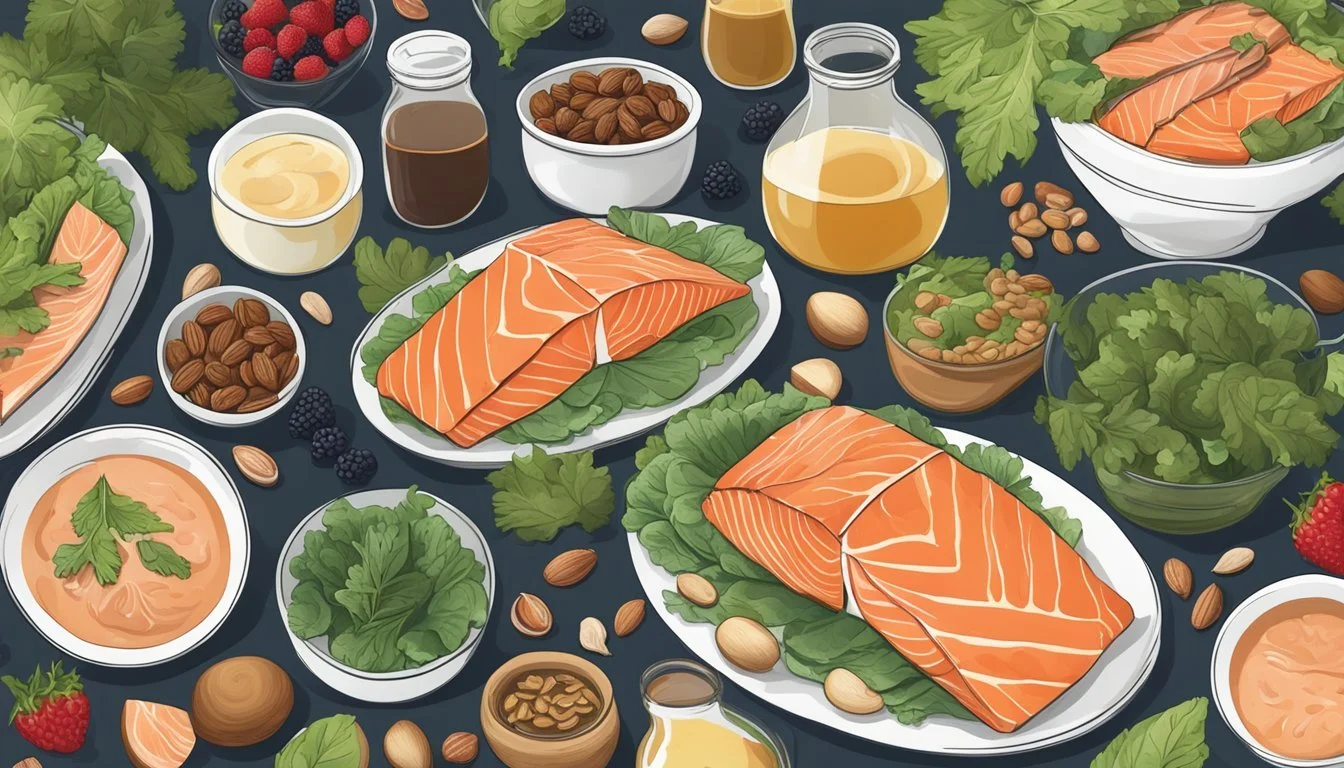Foods Rich in Type 2 Collagen
Essential Benefits and Top Sources
Understanding the importance of collagen in the human body highlights the need to focus on specific types and their sources. Collagen, a fundamental protein, contributes to skin elasticity, joint health, and bone strength. Among the various types, type 2 collagen is particularly vital for supporting joint function and overall connective tissue health.
Incorporating foods high in type 2 collagen into your diet can lead to noticeable improvements in joint comfort and flexibility. These foods can play a crucial role in maintaining cartilage health and reducing the symptoms of joint disorders. By paying attention to one's diet, individuals can naturally support and enhance their body's collagen levels.
1) Chicken Cartilage
Chicken cartilage is a rich source of type II collagen. This type of collagen is crucial for joint health and is often used in supplements aimed at alleviating joint pain and arthritis symptoms.
The cartilage is usually found in chicken joints, such as the knees and sternum. Consuming these parts can provide a natural source of collagen.
Chicken cartilage can be incorporated into your diet through chicken bone broth. This broth is made by simmering the bones and cartilage over a long period, allowing the collagen to break down and be extracted into the broth.
Another way to consume chicken cartilage is by eating the joints directly in soups or stews. These dishes often include the bones and connective tissues, providing an excellent source of collagen.
Chicken cartilage offers not only collagen but also essential amino acids. These amino acids help in the synthesis of new collagen in the body, promoting overall tissue health.
2) Bone Broth
Bone broth is a popular source of type 2 collagen. Made by simmering animal bones, particularly those from chicken or beef, it extracts essential nutrients, including collagen.
Type 2 collagen is beneficial for joint health. Bone broth is often recommended for those looking to support their cartilage and reduce joint discomfort.
Chicken bones are particularly effective for type 2 collagen extraction. Adding vegetables like carrots, celery, and onions can enhance the flavor and nutrient content.
Bone broth is versatile. It can be consumed as a soup, used in recipes, or taken as a warm beverage. This makes it easy to incorporate into daily diets.
Overall, bone broth stands out as a natural, nutritious source of type 2 collagen. Enjoying it regularly can contribute to joint well-being and provide a comforting, richly flavored addition to meals.
3) Fish collagen peptides
Fish collagen peptides are derived from the skin and scales of fish. These sources are abundant in type I collagen, but they can also provide type II collagen, particularly beneficial for joint health.
Type II collagen is crucial for maintaining the cartilage in joints. Fish collagen peptides have a high concentration of amino acids like proline, glycine, and hydroxyproline, which support the body's natural collagen synthesis.
These peptides are bioavailable, meaning they are easily absorbed by the body, making them an efficient source of necessary amino acids. This bioavailability enhances the benefits of collagen supplements derived from fish collagen peptides.
In addition to joint health, fish collagen peptides may also contribute to skin elasticity and hydration. They are often included in dietary supplements and skincare products due to their effectiveness.
Research on fish collagen peptides has highlighted their role in supporting healthy aging. Including them in the diet can be a practical approach to maintaining joint and skin health.
Fish collagen peptides can be found in various forms, such as powders, capsules, and liquid supplements. They are often favored for their neutral flavor and easy integration into daily meals and beverages.
4) Bovine Collagen Powder
Bovine collagen powder is derived from the connective tissues, bones, and hides of cows.
This powder is a rich source of type 2 collagen, which is crucial for maintaining healthy cartilage and joints.
It comes in multiple forms, including powders that can be mixed with beverages and smoothies.
Bovine collagen powder often contains types I and III collagen too, which contribute to skin elasticity and muscle repair.
Regular intake can support joint function and help alleviate symptoms of arthritis.
Due to its high protein content, this supplement is also popular among athletes for muscle recovery.
Incorporating bovine collagen powder into the diet underscores its versatility and health benefits.
5) Eggshell membrane
Eggshell membrane serves as a unique and potent source of collagen, specifically containing significant amounts of Type I collagen along with lesser quantities of Types V and X. This thin layer between the hard shell and the egg white contains essential nutrients beneficial for joint health.
Type V collagen, found in eggshell membrane, plays a vital role in forming skin, hair, and the cornea of the eyes. Type X collagen, also present, is crucial for cartilage and bone formation, supporting the integrity and function of joints.
In addition to collagen, eggshell membrane features other beneficial compounds such as glucosamine, chondroitin, glycosaminoglycans, and hyaluronic acid. These substances further enhance its positive impact on joint and connective tissue health.
Eggshell membrane collagen is particularly valuable because collagen is not commonly found in a wide variety of foods. Including eggshell membrane supplements in a diet can effectively increase collagen intake and provide benefits for skin health and exercise recovery.
6) Collagen-rich pork rinds
Pork rinds are derived from the skin of pigs and are notably high in collagen. With approximately 7-10 grams of collagen protein per serving, they offer more collagen than many other snack foods and even surpass most other foods in collagen content.
Collagen is crucial for maintaining healthy skin, bones, and joints. Pork rinds, being rich in this protein, contribute significantly to skin elasticity and hydration. They also support joint health and can help in muscle repair and growth.
In addition to collagen, pork rinds contain other beneficial nutrients. They are high in glycine, an amino acid that plays a role in the body's detoxification processes and supports a healthy digestive system. This makes pork rinds a multifaceted food option for those seeking collagen and other nutritional benefits.
Despite their benefits, it's important to consume pork rinds in moderation. They can be high in sodium and fat, so balancing them with other nutrient-dense foods is advisable.
7) Gelatin Desserts
Gelatin-based desserts are an excellent source of type 2 collagen. Gelatin, derived from collagen, provides essential amino acids beneficial for joint health and skin elasticity.
Common gelatin desserts include jellies, puddings, and marshmallows. These treats can incorporate fruits, providing added vitamins and enhancing nutritional value.
Grass-fed gelatin is recommended. It ensures the highest quality and nutritional benefits, avoiding unwanted additives.
Adding gelatin to desserts is simple. It dissolves easily in warm liquids, making it versatile for various recipes.
Homemade gelatin desserts allow control over ingredients. This option avoids excessive sugars and artificial additives found in store-bought varieties.
Making gelatin desserts at home also allows customization. Flavors, sweeteners, and additional nutrients can be tailored to personal preferences.
8) Turkey neck
Turkey neck, a common concern as people age, refers to the sagging skin under the chin that resembles a turkey's wattle.
To improve the appearance of turkey neck, one can incorporate certain exercises. Daily neck exercises can strengthen the underlying muscles, potentially helping to reduce sag and firm up the skin.
Nutrition plays a vital role as well. Foods rich in collagen, like meat on the bone and certain organ meats, can support the skin's structure. Additionally, consuming adequate vitamin C through fruits like kiwi and guava can assist in collagen synthesis, which is important for skin elasticity.
Protein-rich foods, such as eggs, can also be beneficial. While egg whites and yolks don't contain collagen, the membranes do. These membranes provide nutrients that can support skin health.
Carotenoid-rich vegetables like carrots, pumpkin, and tomatoes offer protective antioxidants. These compounds neutralize free radicals, helping to prevent premature skin aging and damage.
Regularly including these nutrients in one's diet, combined with targeted exercises, can contribute to a firmer, more youthful neckline.
9) Salmon skin
Salmon skin is an excellent source of type 2 collagen. This part of the fish contains connective tissues that provide the collagen necessary for joint and skin health.
Eating salmon skin can help support the body's natural collagen production. This can be particularly beneficial for individuals looking to improve their skin elasticity and reduce signs of aging.
In addition to collagen, salmon skin is rich in omega-3 fatty acids. These healthy fats play a significant role in reducing inflammation and promoting overall skin health.
Incorporating salmon skin into your diet can be done in various ways, such as grilling or baking the fish with the skin on. This ensures the retention of valuable nutrients while adding a delicious and unique texture to meals.
People interested in a food-first approach to collagen intake may find salmon skin to be a convenient and tasty option. The preparation involves minimal extra effort, making it a practical addition to regular diets.
10) Collagen-infused bone broth protein
Collagen-infused bone broth protein is a staple for those seeking to boost their collagen intake. Derived from simmering beef or chicken bones, this broth is dense with type 2 collagen, integral for cartilage health.
Type 2 collagen is crucial for joint support. By consuming bone broth, individuals can help maintain the elasticity and strength of their cartilage.
Bone broth is also rich in amino acids such as glycine and proline. These amino acids play a role in collagen synthesis within the body.
In addition to collagen, bone broth provides nutrients like calcium, magnesium, and phosphorus. These minerals support overall bone health.
Incorporating collagen-infused bone broth protein into one's diet can be as simple as sipping a warm mug of broth or using it as a base for soups and stews.
Understanding Type 2 Collagen
Type 2 collagen is essential for maintaining joint health and differs significantly from Type 1 collagen in its structure and function. This section explores its crucial role in joint support and the main differences between Type 1 and Type 2 collagen.
Role in Joint Health
Type 2 collagen is primarily found in elastic cartilage, making up a critical part of the cartilage that cushions the joints. Its unique structure allows it to provide the tensile strength and elasticity necessary for smooth and pain-free joint movement.
With aging and wear and tear, the body's production of Type 2 collagen can decrease, leading to joint discomfort and conditions like osteoarthritis. Boosting intake through foods like chicken bone broth or supplements can help mitigate these effects and support joint health.
Differences Between Type 1 and Type 2 Collagen
Type 1 collagen is densely packed and primarily found in skin, tendons, bones, and ligaments, providing structure and support. In contrast, Type 2 collagen forms the elastic cartilage that cushions joints.
While Type 1 is the most abundant collagen in the human body, Type 2 is key for joint flexibility and durability. It's tailored for structures needing a combination of strength and flexibility, unlike Type 1, which is more rigid.
These differences underscore the importance of each type in maintaining different aspects of the body's structural integrity. Understanding these distinctions helps in selecting the appropriate dietary sources and supplements to target specific health needs.
Benefits of Consuming Type 2 Collagen
Consuming Type 2 collagen can significantly contribute to enhanced joint health, providing improved mobility and supporting cartilage repair. These benefits are integral to maintaining a more active and pain-free lifestyle.
Improved Mobility
Type 2 collagen is critical for joint health and functionality. Found predominantly in articular cartilage, it provides the tensile strength and elasticity joints need to move smoothly.
Regular intake of Type 2 collagen has been shown to improve joint mobility in individuals with joint stiffness. This is particularly beneficial for athletes, the elderly, and those with arthritis. Using collagen supplements can reduce inflammation and joint pain, contributing to easier movement and overall quality of life.
Support for Cartilage Repair
Cartilage repair is essential for sustaining joint health and preventing chronic pain or degeneration. Type 2 collagen serves as a primary building block for cartilage, supporting its structure and resilience.
Ingesting Type 2 collagen helps stimulate the body's natural collagen production, enhancing the repair and maintenance of joint cartilage. This is important for those recovering from joint injuries or dealing with degenerative diseases such as osteoarthritis. Regular consumption can aid in long-term joint health, reducing the need for invasive treatments or medications.
How to Incorporate Collagen-Rich Foods into Your Diet
Adding collagen-rich foods to your diet can benefit your skin, joints, and overall health. Utilizing specific preparation methods and nutrient pairings can maximize collagen absorption and its effects.
Cooking and Preparation Tips
Consuming collagen-rich foods is most effective when these foods are prepared correctly. Bone broth, made from simmering animal bones for hours, is an excellent source of type 2 collagen. It can be used as a base for soups, stews, or consumed on its own.
Chicken cartilage can also be a rich source. When preparing chicken wings or drumsticks, it's essential to include the cartilage. Cooking them in a slow cooker ensures the collagen is well-extracted.
Incorporating gelatin, which is derived from collagen, into your desserts or smoothies is another simple method. Make sure to avoid high temperatures as they might degrade the collagen.
Fish skin and bones, especially from species like salmon or mackerel, are rich in collagen. Grilling or baking with the skin on ensures that you get the benefits.
Combining with Other Nutrients
Pairing collagen-rich foods with nutrients that aid collagen production can enhance effectiveness. Vitamin C is crucial for collagen synthesis. Foods like citrus fruits, strawberries, and bell peppers can be combined with collagen sources.
For example, a chicken salad with red peppers or an orange slice can boost collagen benefits. Copper, found in nuts and seeds, also plays a role. Consider adding nuts to your dishes where collagen-rich foods are primary elements.
Additionally, zinc supports collagen production. Incorporate zinc-rich foods like shellfish or leafy greens alongside collagen sources. For instance, a bone broth soup paired with spinach can be a nourishing option.
These combinations ensure that the body has all the necessary building blocks to make the most of dietary collagen.












